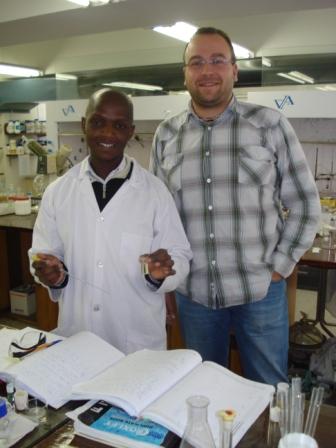
Dr Christian Litwinski, Nanotechnology Specialist at the Nanotechnology Innovation Center (NIC) at Rhodes’ Chemistry Department has been awarded a joint research grant from the National Research Foundation (NRF) to conduct pioneering cancer research in the field of functional nanodrugs as photosynthesisers in Photodynamic Therapy (PDT).
Dr Litwinski, who joined Rhodes as a post doctoral fellow in 2009 after studying physics in Berlin, will work together with colleagues from Charite-Universitatsmedizin, Berlin as part of the R300 000 collaborative research project, aimed at improving the effectiveness of existing nanodrugs. This will involve creating an interface between semiconductor quantum dots (QDs) and living tumor cells allowing high selectivity, low light and drug doses needed for PDT and diagnosis (PDD) treatments. As part of the collaboration, Dr Litwinski and his co-workers at Rhodes will be responsible for the synthesis and photophysical characterisation of nanodrugs, while Charite University’s team will conduct cell and animal experiments to test the drugs.
PDT is a treatment that uses photosensitising agents along with light to kill cancer cells. Its mechanism of action involves three key components; a photosensitiser, light and tissue oxygen. The combination of these three components causes the destruction of tumor cells. Dr Litwinski said that while nanodrugs as a photosensitiser offer significant potential for non-invasive cancer treatment, they have been limited. “One problem of cancer treatment with PDT is the selectivity. Existing drugs not only enter cancerous cells but also healthy ones which will be destroyed along with the cancerous ones. What we are trying to work on is to create a nanodrug which will have the selectivity and is a diagnostic tool and photosensitiser at the same time,” he said.
He first came across PDT during his PhD in physics and was fascinated by this approach to healing cancer. PDT can be used to treat other skin diseases but Dr Litwinski said with the prevalence of cancer worldwide, he has chosen to focus in this area. “There have been a few shortfalls with the therapy in the past and I want to contribute to solving them,” he said. The project, which started in April this year and continue until March 2013, requires interdisciplinary collaboration, which Dr Litwinski said he is anticipating. “I really enjoy the interdisciplinary approach. As a physicist I work closely with chemists at Rhodes and will now be working with medical doctors and biologists in Berlin. I am very excited to learn from other disciplines,” he said.
As part of the collaboration with Charite University, numerous exchange programs will be organised between German and South African-born Rhodes students involved in the research. Dr Litwinski said he is aiming to get two students per year involved in the exchanges, which will involve Rhodes students going to Germany to conduct cell and animal experiments, and German students coming to Rhodes to synthesise and investigate the nanodrugs. “This is a great opportunity for Rhodes students to go overseas and learn to conduct cell and animal experiments. The idea is to expose students to new fields of research,” he said.
Kutloano Edward Sekhosana, a Masters student in Chemistry at Rhodes is currently preparing himself for one of the exchanges, which is planned to take place between August and September this year. Sekhosana, who completed his undergraduate at the University of Zululand before joining Rhodes as a Masters student this year, said he is anticipating the research trip, especially since it will involve a combination of physics and chemistry. “I have been looking to do something involving a combination of these two disciplines, and this project gives me that opportunity. I’m so excited to go over there,” he said.
Dr Litwinski said he wishes to thank his colleague Professor Nyokong, who provided the facilities of the Nanotechnology Innovation Centre (NIC) and the Chemistry department, without which his work in this field would not have been possible.
Story and photo by Sarah-Jane Bradfield
Photo: Kutloano Edward Sekhosana and Dr Christian Litwinski
